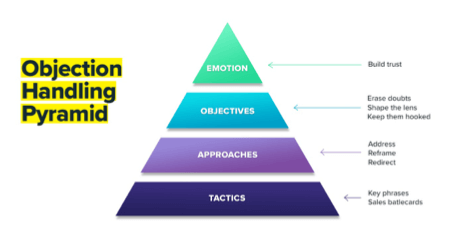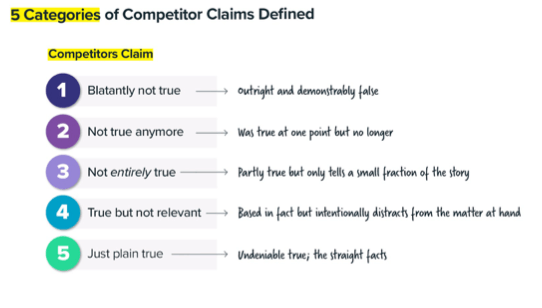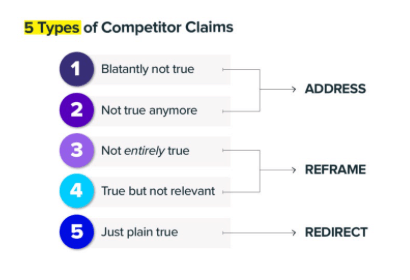Who doesn’t love a good acronym? They’re fun to say, make you sound smart, and pack a whole lot of meaning into just a couple of letters.
The revenue types may already be familiar with one ARR acronym, but now it’s time for another to share the spotlight.
When it comes to objection handling in sales, ARR stands for Address, Reframe, and Redirect. Each refers to an approach you can employ to handle and overcome common objections.
In this article, we'll focus on five different types of competitor claims:
- Blatantly not true,
- Not true anymore,
- Not entirely true,
- True but not relevant, and
- Just plain true.
The right approaches are a critical component of the objection handling process. It’s at this point in the Objection Handling Pyramid where we move from understanding the ‘why’ of objection handling and move on to the what.

Of course, one size never fits all when it comes to handling objections. Whether you Address, Reframe, or Approach will depend on the type of competitor claim or buyer objection you’re looking to overcome.
Each of these approaches focuses on how you can turn an objection into an opportunity. This can be especially useful when your prospective buyer already uses the competition.
For Kevin Dorsey, VP of Inside Sales at Patient Pop Inc., these types of negotiations provide a unique opportunity for overcoming objections:
"If you're targeting an account that uses your competitor, it means they've already made the leap to solve the problem that you're trying to solve. Going after a competitor is actually a great thing because [your prospect] already opened the doors on why they should make the change."
Approaching five different types of competitor claims
At the risk of over-simplifying things, you can bucket objections and competitor claims into two overarching categories: true and untrue. But within these two large buckets are five subcategories of claims.

At the extremes are claims which are either blatantly true or blatantly false. No matter how you slice it, these claims are supported (or unsupported) by objective evidence.
In the middle are claims that contain elements of truth but leave ample room for interpretation, and demand more context. The context you can use to your advantage in the objection handling process and in your approaches.
How to overcome untrue objections
If the objection you’re looking to overcome is blatantly not true or not true anymore, you should take the same approach.
The best tactic to employ in this instance is to ADDRESS the claim head-on.
Here are two examples of false claims drawn from real-life objections:
1) Blatantly not true
CLAIM: “The other vendor we’re considering in this deal says they’re the undisputed leader in your category. Why would we go with you instead?”
CONTEXT: Some of you may recall a time when you had to back up these ‘best in the world’ claims with evidence. Sadly, many of your competitors will suggest they are the undisputed leader when there is in fact much to be disputed.
APPROACH: ADDRESS this objection head-on. Demonstrate the claim is false by using third-party validation.
Reputable review services like G2, legitimate industry groups, and other objective data points can all support your position and help you correct the record.
TALK TRACK: “I’m not sure what else they told you, but the reality is we rank higher in customer satisfaction and ease of adoption based on over 500 reviews. Also, market data highlighted in [insert report] shows very clearly that we are head and shoulders above the competition.”
2) Not true anymore
CLAIM: “Slack integration is something that’s really important for our team. Your competitor told us theirs is the only platform with an integration.”
CONTEXT: Overcoming sales objections is really an opportunity to be on the offensive. A claim that perhaps was once true but is no longer true is a prime example of an opportunity to turn the falseness of a claim right back on your competitor.
APPROACH: Not only are these sorts of claims easily disprovable, but you should also leverage the opportunity to highlight the big swing and a miss your competitor struck out on. Again, you should ADDRESS this type of claim head-on.
TALK TRACK: “It looks like they’ve got some very outdated intel on this topic. We announced full integration with Slack in our Q1 product release. Our platform also seamlessly integrates with Salesforce.”
Overcoming partly true objections
No product is perfect. Even the most widely-used products and services are not airtight. Your competitors will inevitably gather intel on these gaps and use them to deposition you in competitive deals.
But guess what, your competitor ain’t perfect either. That’s why overcoming objections that are not entirely true, or true but not relevant, demands a Reframe approach.
3) Not entirely true
CLAIM: “It looks to me like your functionality is exactly the same as the other vendor we’re looking at.”
CONTEXT: It’s true that you and your competitor will often appear similar on the face of things. With over 8000 martech companies fighting for their spot at the table, differentiation is increasingly difficult.
APPROACH: Reframe this objection by acknowledging the partial truth. Follow that up with your key differentiation points focusing on the underlying gap the prospect is trying to fill. Highlighting why your product solves the problem better.
TALK TRACK: “The interface looks similar for sure. But when the content we curate and how we do it is a better fit for your needs.”
4) True but not relevant
CLAIM: “This is just adding another program for my salespeople to use. They’re not going to use it.”
CONTEXT: For the prospect making this claim, it feels true to them that their sales reps won’t want to use an additional app or program. But past experience isn’t relevant to you winning the deal at present. And the claim being made here speaks more to the irrelevance of their current tech stack than anything to do with what you bring to the table.
APPROACH: Reframe this objection by circling back to the relevance of your product to fit their needs.
TALK TRACK: “We should avoid using assumptions about what sales reps want and need. Do you currently measure the consumption of your competitive intelligence?
5) Just plain true
The facts are the facts. There will be limitations to what problems your product can solve no matter how powerful it is. As long as you know your weak spots, there is no reason to fret objections that are plainly true. Instead, make use of the second R in ARR and REDIRECT the conversation.
CLAIM: “Your program doesn’t work in Mandarin. We do business in China and need to have that functionality.”
CONTEXT: Whether it’s an integration your engineering hasn’t figured out yet or any other kind of limitation, you can’t be everything to everyone at all times. Luckily your product still does a hell of a lot!
APPROACH: Redirect the prospect towards your product’s strong points, while acknowledging the limitation.
TALK TRACK: “We see things a little differently. Right now our machine learning isn’t attuned to Mandarin. But we can sync up to anything with an RSS feed, and there are zero language limitations when it comes to building your team’s battlecards. It’s great feedback though and we’re working on a solution for this that we will hopefully roll out in the future.”
Establishing tactics for objection handling
The objection handling techniques featured above start with a conceptual approach and then move into tangible tactics when it comes time to address, reframe or redirect.
Deciding what to say, to whom, and when is not improvised on the spot. Rather it is established and informed by intentional preparation beforehand.
As Clara Smyth, Sr. Marketing Manager at Slack explained at the first-ever Competitive Enablement Summit, “I would highly recommend creating something like an internal-facing objection handling guide, external-facing competitive case studies, and then feature function matrices.”
However, tactics are the last step in the Objection Handling Pyramid. So we’ll save that for another blog.

Overcoming sales objections in competitive deals is an absolute certainty in the life of a sales rep. And it can be a struggle for the greenest rookies to the most grizzled veterans.
Add a new acronym to your vocabulary and set yourself up for success with the ARR of objection handling.
Step 1:
Categorize your competitor’s claim into one of five categories:
- Blatantly not true
- Not true anymore
- Not entirely true
- True, but not relevant
- Just plain true
Step 2:
Decide if Address, Reframe, or Redirect is the right approach for the claim
Step 3:
Win. More. Deals.
Klue provides a lens into your competitor’s world, continuously updating and connecting dots to help you win more business. It’s a new way to capture, manage, and communicate market insights from the web and across the company, in platforms you already use.


 Follow us on LinkedIn
Follow us on LinkedIn
